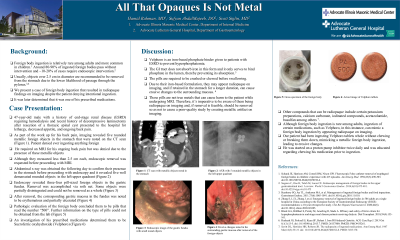Monday Poster Session
Category: General Endoscopy
P2410 - All That Opaques is Not Metal
Monday, October 28, 2024
10:30 AM - 4:00 PM ET
Location: Exhibit Hall E

Has Audio
.jpg)
Hamid U. Rahman, MD
Advocate Illinois Masonic Medical Center
Morton Grove, IL
Presenting Author(s)
Hamid Rahman, MD1, Sufyan AbdulMujeeb, DO2, Scott Siglin, MD3
1Advocate Illinois Masonic Medical Center, Morton Grove, IL; 2Advocate Lutheran General, Niles, IL; 3Advocate Lutheran General, Park Ridge, IL
Introduction: Foreign body ingestion is relatively rare among adults and more common in children. Around 80-90% of ingested foreign bodies pass without intervention, and nearly 10-20% of cases require endoscopic intervention. Usually, objects over 2.5 cm in diameter are recommended to be removed from the stomach due to the lower likelihood of passage through the pylorus.
Case Description/Methods: We present a case of a 47-year-old male who required an MRI for his ongoing back pain but could not get one due to the presence of five rounded metallic foreign objects that were noted on the CT scan, which the patient denied ingesting. Although they measured less than 2.5 cm each, endoscopic removal was requested before proceeding with MRI. Endoscopy revealed a few rounded objects in the fundus with surrounding erosive gastritis. Pathologic evaluation concluded them to be pills, and an investigation of his prescribed medications determined them to be Sucroferric oxyhydroxide (Velphoro).
Discussion: Velphoro is an iron-based phosphate binder given to patients with end-stage renal disease to prevent hyperphosphatemia. Iron in this form is not absorbed by the GI tract and binds to phosphate in the lumen, thereby preventing its absorption. The pills are required to be crushed or chewed before swallowing. Although these pills are not true metals that can cause harm to the patient while undergoing MRI, it is imperative to be aware of them being radiopaque on imaging and, if removal is feasible, should be removed so as not to cause a poor quality study by creating metallic artifacts on imaging. Although these pills are less than 2.5 cm, if they have been present for several days, endoscopic evaluation may be necessary to assess the surrounding erosive mucosal damage. Other compounds that can be radiopaque include certain potassium preparations, calcium carbonate, iodinated compounds, acetazolamide, and busulfan, among others.
Disclosures:
Hamid Rahman, MD1, Sufyan AbdulMujeeb, DO2, Scott Siglin, MD3. P2410 - All That Opaques is Not Metal, ACG 2024 Annual Scientific Meeting Abstracts. Philadelphia, PA: American College of Gastroenterology.
1Advocate Illinois Masonic Medical Center, Morton Grove, IL; 2Advocate Lutheran General, Niles, IL; 3Advocate Lutheran General, Park Ridge, IL
Introduction: Foreign body ingestion is relatively rare among adults and more common in children. Around 80-90% of ingested foreign bodies pass without intervention, and nearly 10-20% of cases require endoscopic intervention. Usually, objects over 2.5 cm in diameter are recommended to be removed from the stomach due to the lower likelihood of passage through the pylorus.
Case Description/Methods: We present a case of a 47-year-old male who required an MRI for his ongoing back pain but could not get one due to the presence of five rounded metallic foreign objects that were noted on the CT scan, which the patient denied ingesting. Although they measured less than 2.5 cm each, endoscopic removal was requested before proceeding with MRI. Endoscopy revealed a few rounded objects in the fundus with surrounding erosive gastritis. Pathologic evaluation concluded them to be pills, and an investigation of his prescribed medications determined them to be Sucroferric oxyhydroxide (Velphoro).
Discussion: Velphoro is an iron-based phosphate binder given to patients with end-stage renal disease to prevent hyperphosphatemia. Iron in this form is not absorbed by the GI tract and binds to phosphate in the lumen, thereby preventing its absorption. The pills are required to be crushed or chewed before swallowing. Although these pills are not true metals that can cause harm to the patient while undergoing MRI, it is imperative to be aware of them being radiopaque on imaging and, if removal is feasible, should be removed so as not to cause a poor quality study by creating metallic artifacts on imaging. Although these pills are less than 2.5 cm, if they have been present for several days, endoscopic evaluation may be necessary to assess the surrounding erosive mucosal damage. Other compounds that can be radiopaque include certain potassium preparations, calcium carbonate, iodinated compounds, acetazolamide, and busulfan, among others.
Disclosures:
Hamid Rahman indicated no relevant financial relationships.
Sufyan AbdulMujeeb indicated no relevant financial relationships.
Scott Siglin indicated no relevant financial relationships.
Hamid Rahman, MD1, Sufyan AbdulMujeeb, DO2, Scott Siglin, MD3. P2410 - All That Opaques is Not Metal, ACG 2024 Annual Scientific Meeting Abstracts. Philadelphia, PA: American College of Gastroenterology.
